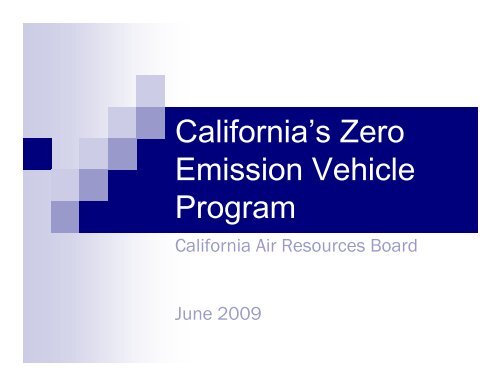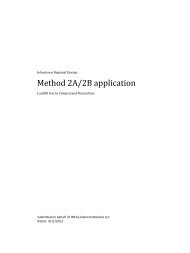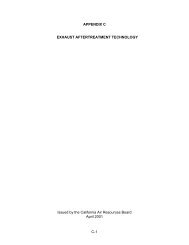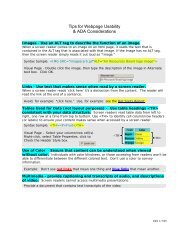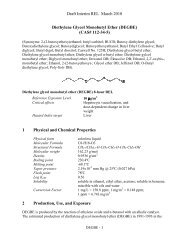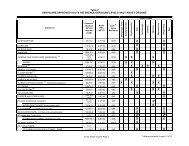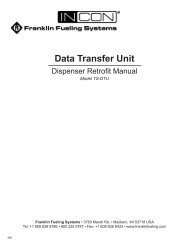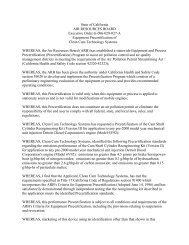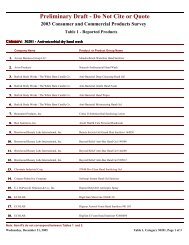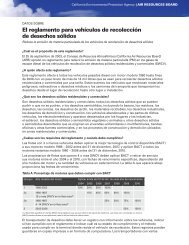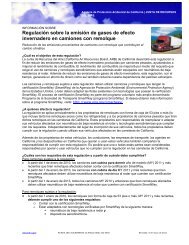ZEV Tutorial - California Air Resources Board
ZEV Tutorial - California Air Resources Board
ZEV Tutorial - California Air Resources Board
Create successful ePaper yourself
Turn your PDF publications into a flip-book with our unique Google optimized e-Paper software.
<strong>California</strong>’s Zero<br />
Emission Vehicle<br />
Program<br />
<strong>California</strong> <strong>Air</strong> <strong>Resources</strong> <strong>Board</strong><br />
June 2009
1. Viewer Window 2. Control Panel<br />
GoToWebinar Attendee Interface
Overview<br />
�� Why have a <strong>ZEV</strong> regulation?<br />
�� History: How did we get here?<br />
�� The 2009 Regulation<br />
�� ARB’s ARB role in <strong>ZEV</strong> Commercialization<br />
�� Section 177 States<br />
�� Looking Forward: <strong>ZEV</strong> 2.0<br />
�� Conclusion
Why have a <strong>ZEV</strong><br />
regulation?
Over 90% of <strong>California</strong>ns Breathe<br />
Unhealthy <strong>Air</strong> at Times<br />
Days Over State 24-Hour<br />
PM10 Standard<br />
Source: ADAM<br />
September 2006 (tfn)<br />
Days Over State 8-Hour<br />
Ozone Standard<br />
Source: MRedgrave<br />
May 2006 (mln)<br />
0-5 Days 6-50 Days 50-100 Days >100 Days
The Challenge...<br />
� Over 23 million registered vehicles<br />
� Over 797 million miles driven every day<br />
� Over 37 million gallons of gasoline consumed<br />
each day<br />
2<br />
1.8<br />
1.6<br />
1.4<br />
1.2<br />
1<br />
0.8<br />
1980<br />
1982<br />
1984<br />
1986<br />
1988<br />
Vehicle Miles Traveled<br />
1990<br />
1992<br />
1994<br />
1996<br />
1998<br />
Population<br />
2000
0.4<br />
0.35<br />
0.3<br />
0.25<br />
0.2<br />
0.15<br />
0.1<br />
0.05<br />
0<br />
Goal is Near-Zero Near Zero Emissions<br />
(g/mile)<br />
HC<br />
NOx<br />
1994 2004 2010<br />
CBG<br />
Phase 3<br />
LEV I LEV II
Climate Change in <strong>California</strong><br />
<strong>California</strong> Projected Impacts<br />
� 75% loss in snow pack<br />
� 1-2 foot sea level rise<br />
� 70 more extreme heat days/year<br />
� 80% more ‘likely ozone’ days<br />
� 55% more large forest fires<br />
� Twice the drought years
<strong>California</strong> GHG Goals<br />
� Initiated through AB 32:<br />
� AB 1493: Pavley Regulation<br />
� By 2020, reduce GHGs back to 1990 levels<br />
� By 2050, reduce GHG 80% from 1990 level<br />
by 2050
2002-2004 2002 2004 GHG Emissions<br />
(469 MMTCO2E)<br />
Recycling/Waste,<br />
1%<br />
Res & Com, 9%<br />
Agriculture, 6%<br />
Industrial, 19%<br />
Electricity<br />
(Imports), 12%<br />
High GWP, 3%<br />
Transportation,<br />
38%<br />
Electricity (In<br />
State), 11%<br />
10
On-Road On Road Transportation Sources<br />
2020<br />
Passenger Vehicles<br />
~ 160 MMTCO2E<br />
Heavy-Duty Vehicles<br />
~ 50 MMTCO2E<br />
Passenger<br />
Vehicles<br />
76%<br />
Heavy<br />
Duty<br />
Vehicles<br />
24%<br />
*Preliminary ARB GHG Projections for 2020
Percent of 1990 Growth<br />
200%<br />
190%<br />
180%<br />
170%<br />
160%<br />
150%<br />
140%<br />
130%<br />
120%<br />
110%<br />
100%<br />
90%<br />
80%<br />
1990<br />
1992<br />
Historical and Projected Population, Vehicle Miles<br />
1994<br />
1996<br />
1998<br />
2000<br />
Traveled (VMT) and GHG Growth<br />
2002<br />
2004<br />
2006<br />
2008<br />
2010<br />
2012<br />
2014<br />
2016<br />
2018<br />
2020<br />
2022<br />
2024<br />
2026<br />
2028<br />
2030<br />
VMT<br />
GHG Growth<br />
GHG Growth<br />
with AB 1493<br />
GHG Growth<br />
with AB 1493<br />
and LCFS
History: How Did<br />
We Get Here?
Paul MacCready<br />
1982: GM Sunraycer<br />
solar EV<br />
GM Impact Photo:www.greencar.com<br />
GM Sunraycer Photo: www.carstyling.ru<br />
1989 Santana<br />
(Impact/EV1) tested at<br />
GM proving grounds in<br />
Arizona
1990: ARB LEV I<br />
� Declining Fleet Average Requirement<br />
� Initial <strong>ZEV</strong> requirement located within<br />
LEV I as footnote:<br />
“While meeting the fleet average standards,<br />
each manufacturer’s sales fleet shall be<br />
composed of at least 2% <strong>ZEV</strong>s in the model<br />
years 1998 through 2000, 5% <strong>ZEV</strong>s in 2001 and<br />
2002 and 10% <strong>ZEV</strong>s in 2003 and subsequent.”
1990: <strong>ZEV</strong> Program Rationale<br />
� Projected improvements in conventional<br />
technology not sufficient to meet air quality<br />
standards<br />
� <strong>ZEV</strong>s avoid ICE vehicle emissions<br />
performance deterioration with age
1996: <strong>ZEV</strong> Regulation<br />
� 10% <strong>ZEV</strong>s in 2003<br />
� Early requirements eliminated<br />
� ARB established agreements with large<br />
automakers to place technology demonstration<br />
fleet (“MOA” Vehicles):<br />
� MOA vehicles very successful in operation<br />
� Automakers claimed marketability challenges<br />
� Design distinctions:<br />
� Most of those with reasonable performance made use of<br />
advanced batteries, except the Panasonic EV1<br />
� All used 2-4 x the energy per mile as a Panasonic EV1
1998: LEV II and <strong>ZEV</strong><br />
� LEV II: Lower emission stds for all vehicle<br />
categories<br />
� New SULEV emission standard<br />
� Near and zero evaporative requirements<br />
� <strong>ZEV</strong>: moved to its own section (1962)<br />
� Partial <strong>ZEV</strong> (P<strong>ZEV</strong>) credits for qualifying<br />
technologies<br />
� P<strong>ZEV</strong>s substitution up to 6 percent for LVMs
1998: P<strong>ZEV</strong>s<br />
� SULEV exhaust emissions<br />
� Dual wall exhaust manifolds, close coupled catalyst plus<br />
downstream catalyst w/ integral adsorbers, linear O2<br />
sensor, retarded timing at cold start, electric air<br />
injection, greater catalyst loading<br />
� Zero evaporative emissions<br />
� Add. trap on canister vent, carbon vent on engine inlet,<br />
improved seals at joints/junctions, consolidation of parts<br />
to minimize junctions, better materials<br />
� 15 yr/ 150,000 mi emissions<br />
warranty<br />
� On board-diagnostics
Hybrid Electric Vehicles<br />
1997: Toyota Prius<br />
Believed to be instigated<br />
by PNGV<br />
1998: Honda Insight
2001: <strong>ZEV</strong> Amendments<br />
� Maintained technology forcing mandate<br />
� Phased in <strong>ZEV</strong> and P<strong>ZEV</strong> requirements<br />
� Allowed further offset with Advanced<br />
Technology P<strong>ZEV</strong>s (AT P<strong>ZEV</strong>s)<br />
� Technologies that lead to <strong>ZEV</strong>s<br />
� Segregated NEVs and assigned them<br />
fractional <strong>ZEV</strong> credit<br />
� Gradually increased future <strong>ZEV</strong><br />
requirements
2001: <strong>ZEV</strong> Litigation<br />
� Federal and State lawsuits<br />
� Linked credits to efficiency<br />
� Preliminary injunction issued June 2002,<br />
prohibiting ARB from enforcing the regulation<br />
in 2003 or 2004 model years<br />
� The <strong>Board</strong> modified the regulation in 2003<br />
� Settlement agreement for all cases signed<br />
August 2003
Fuel Cell Vehicles<br />
FreedomCar: FreedomCar:<br />
Cooperative<br />
research effort (Ford, GM, and<br />
DaimlerChrysler)<br />
�� Aimed at longer term goals<br />
<strong>California</strong> Fuel Cell<br />
Partnership
2003: <strong>ZEV</strong> Amendments<br />
� Changed calculation method for AT P<strong>ZEV</strong>s<br />
� Two Paths Created<br />
� Base Path: Banked Credits<br />
� Alternative Path: New placement of <strong>ZEV</strong>s<br />
� Phases allowed vehicles to be placed in grouped<br />
demonstrations<br />
� Phase I: 2005-2008<br />
� Phase II: 2009-2011<br />
� Phase III: 2012-2014<br />
2% 2%<br />
� Phase IV: 2015-2017<br />
� P<strong>ZEV</strong>s – up to 6%<br />
10%<br />
� AT P<strong>ZEV</strong>s – up to 2%<br />
� 2005 Implementation<br />
6%
2004/2005: DOE Hydrogen Program<br />
� Bush commits $1.7 Billion over 5 years<br />
� Energy Policy Act of 2005: authorizes<br />
$3.28 billion<br />
� research and development, demonstrations<br />
and studies over 5 fiscal years aimed at<br />
getting hydrogen-powered autos on the road<br />
by 2020
2006 <strong>ZEV</strong> Expert Panel &<br />
2008 Amendments<br />
� Advances in lithium ion battery technology show<br />
great promise for battery EVs<br />
� Plug-in Hybrid Electric Vehicles (PHEVs) likely<br />
to be commercially successful<br />
� Encourage the production of plug-in hybrid<br />
electric vehicles (PHEV)<br />
� Needed to be an adjustment in required number<br />
of <strong>ZEV</strong>s<br />
� Transparency
The 2009 <strong>ZEV</strong><br />
Regulation
<strong>ZEV</strong> Regulation Steps<br />
<strong>ZEV</strong> Regulation Steps<br />
� Step 1: Size Determination<br />
� Step 2: <strong>ZEV</strong> Base Volume Determination<br />
� Step 3: Requirement Determination<br />
� Step 4: Allowances<br />
� Step 5: Applicable Multiplier Determination<br />
� Step 6: Total Credit Calculation<br />
� Step 7: Rules on Credit Use<br />
� Step 8: Special Provisions<br />
� Step 9: Travel Provision<br />
� Step 10: Demonstration of Compliance<br />
� Step 11: Penalties
Step 1: Size Determination<br />
Why Size Matters…<br />
� Small (SVM)<br />
� CA sales less than 4,500; Not Subject<br />
� Independent Small (ISVM)<br />
� CA sales less than 10,000; Not Subject<br />
� Intermediate (IVM)<br />
� CA sales between 4,501 and 60,000; Subject to<br />
Regulation<br />
� Can meet whole requirement with P<strong>ZEV</strong>s<br />
� Large (LVM)<br />
� CA sales greater than 60,000; Subject to Regulation
Step 1: Size Determination<br />
� Rolling average based on previous three<br />
consecutive model years sales of PC, LDTs,<br />
and MDVs<br />
MY 2009 Example:<br />
2006<br />
59,745<br />
2007<br />
63,800<br />
2008<br />
67,350<br />
Average: 63,631<br />
Therefore, subject to LVM requirements
Step 1: Size Determination<br />
What if my size changes?<br />
� Due to Size Increase:<br />
� SVM IVM = 5 year lead time<br />
� IVM LVM = 5 year lead time<br />
� Due to Size Decrease:<br />
� IVM SVM = Following MY<br />
� LVM IVM = Following MY<br />
� Due to New Majority Ownership Agreements:<br />
� IVM+IVM = LVM : 3 year lead time
Step 1: Size Determination<br />
Example: Increase in Size<br />
MY<br />
Sales<br />
2004<br />
45,000<br />
Averages<br />
2004-2006: 52,333<br />
2005-2007: 58,333<br />
2006-2008:<br />
62,000<br />
2009<br />
Avg. over<br />
60,000<br />
2010<br />
2005<br />
53,000<br />
2011<br />
2012<br />
2006<br />
59,000<br />
Still subject IVM Requirements<br />
2013<br />
2007<br />
63,000<br />
2014<br />
2008<br />
64,000<br />
Subject to LVM<br />
Requirements
Step 1: Size Determination<br />
How does ownership affect my size for <strong>ZEV</strong>?<br />
� If one manufacturer has 50% or greater<br />
ownership in another manufacturer, their<br />
sales are aggregated for determining size<br />
MY 2009 Example<br />
Company A owns 60% of Company B (as of June 2003)<br />
Company A 2006-08 Sales Average: 43,500<br />
Company B 2006-08 Sales Average: 36,000<br />
Company A and B Aggregated 2006-08 Sales: 79,500<br />
Both are subject to the LVM <strong>ZEV</strong> requirements
Step 2: <strong>ZEV</strong> Base Volume Determination<br />
What do you mean by <strong>ZEV</strong> Base Volume?<br />
� The production volume on which your<br />
<strong>ZEV</strong> requirement is based<br />
� Has nothing to do with your size<br />
determination calculation method
Step 2: <strong>ZEV</strong> Base Volume Determination<br />
� A total or average of PCs, LDT1s, and<br />
LDT2s (as applicable)<br />
� Two Methods: You can switch every year<br />
� Prior Years Method<br />
� An average of the previous 4 th , 5 th , and 6 th<br />
model year from model year in which you are<br />
complying<br />
� Same Year Method<br />
� A projection of sales for the model year in which<br />
you are complying (2009 MY, use 2009 Sales)
Step 2: <strong>ZEV</strong> Base Volume Determination<br />
Prior Years Method<br />
� 2009 MY Example<br />
2009 Compliance Year<br />
2008 1st<br />
2007 2nd<br />
2006 3rd<br />
2005 4th<br />
2004 5th<br />
2003 6th<br />
} For<br />
the 2009 MY, manufacturers would<br />
use their 2003-2005 sales average<br />
when choosing the prior years method
Step 2: <strong>ZEV</strong> Base Volume Determination<br />
� “LDT2s, as applicable”<br />
� You will add increasingly in your LDT2 production<br />
over three model years to your <strong>ZEV</strong> Base Volume<br />
2009<br />
51%<br />
2010<br />
68%<br />
2011<br />
85%<br />
2012<br />
100%<br />
� Prior Years Method: Add together LDT2 production<br />
from previous model years, take average, then<br />
multiply %<br />
� Same Year Method: Multiply % to LDT2 production
Step 3: <strong>ZEV</strong> Requirement<br />
Yearly <strong>ZEV</strong> Requirements<br />
2009-2011<br />
11%<br />
2012-2014<br />
12%<br />
2015-2017<br />
14%<br />
2018+<br />
16%<br />
�� Regulation dictates how requirement must and<br />
may be met<br />
��Types Types of required and allowed vehicles: <strong>ZEV</strong>s, <strong>ZEV</strong>s,<br />
Enhanced AT P<strong>ZEV</strong>s, P<strong>ZEV</strong>s,<br />
AT P<strong>ZEV</strong>s, P<strong>ZEV</strong>s,<br />
and P<strong>ZEV</strong>s
Step 3: <strong>ZEV</strong> Requirement<br />
Let’s Rank the Vehicle Credits:<br />
1. <strong>ZEV</strong>s (Gold)<br />
2. Enhanced AT P<strong>ZEV</strong>s (Silver +)<br />
3. AT P<strong>ZEV</strong>s (Silver)<br />
4. P<strong>ZEV</strong>s (Bronze)<br />
� Higher ranked vehicle credits may fulfill<br />
lower ranked credit percentages
<strong>ZEV</strong> Requirement: The <strong>ZEV</strong> Glass<br />
This is how<br />
the <strong>ZEV</strong><br />
requirement<br />
is written<br />
12% <strong>ZEV</strong><br />
2012 MY Example
<strong>ZEV</strong> Requirement: The <strong>ZEV</strong> Glass<br />
A Manufacturer<br />
MUST fulfill their<br />
<strong>ZEV</strong> requirement,<br />
but may fulfill the<br />
rest of their <strong>ZEV</strong><br />
requirement with<br />
Enhanced AT<br />
P<strong>ZEV</strong>s<br />
0.79% <strong>ZEV</strong><br />
11.21% 12% Enhanced <strong>ZEV</strong><br />
AT P<strong>ZEV</strong><br />
2012 MY Example
<strong>ZEV</strong> Requirement: The <strong>ZEV</strong> Glass<br />
A Manufacturer<br />
MUST fulfill their<br />
<strong>ZEV</strong> requirement,<br />
but may fulfill the<br />
rest of their <strong>ZEV</strong><br />
requirement with<br />
Enhanced AT<br />
P<strong>ZEV</strong>s and AT<br />
P<strong>ZEV</strong>s<br />
0.79% <strong>ZEV</strong><br />
2.21% Enhanced<br />
AT P<strong>ZEV</strong><br />
11.21% 12% Enhanced <strong>ZEV</strong><br />
AT P<strong>ZEV</strong><br />
9% AT P<strong>ZEV</strong><br />
2012 MY Example
<strong>ZEV</strong> Requirement: The <strong>ZEV</strong> Glass<br />
A Manufacturer<br />
MUST fulfill their<br />
<strong>ZEV</strong> requirement,<br />
but may fulfill the<br />
rest of their <strong>ZEV</strong><br />
requirement with<br />
Enhanced AT<br />
P<strong>ZEV</strong>s, AT P<strong>ZEV</strong>s<br />
and P<strong>ZEV</strong>s<br />
0.79% <strong>ZEV</strong><br />
2.21% Enhanced<br />
AT P<strong>ZEV</strong><br />
3% AT P<strong>ZEV</strong><br />
11.21% 12% Enhanced <strong>ZEV</strong><br />
AT P<strong>ZEV</strong><br />
9% AT P<strong>ZEV</strong><br />
6% P<strong>ZEV</strong><br />
2012 MY Example<br />
Most<br />
manufacturers<br />
choose to meet<br />
their requirement<br />
this way because<br />
it is the most cost<br />
effective way to<br />
meet the<br />
regulation
Step 3: <strong>ZEV</strong> Requirement<br />
<strong>ZEV</strong>s: Alternative Path vs. Base Path<br />
� Two paths until 2011<br />
� Alternative Path<br />
� Market share of set number of <strong>ZEV</strong>s<br />
� New production of <strong>ZEV</strong>s<br />
� No banked credits<br />
� May be placed all at one time within 3 year window<br />
� Base Path<br />
� Credits equal to 2% annually<br />
� Banked credits
Step 3: <strong>ZEV</strong> Requirement<br />
2009 – 2011 Alt Path Req.:<br />
� Credits from placed <strong>ZEV</strong>s equal to 0.82% of<br />
2003-2005 average annual sales<br />
OR<br />
� A manufacturer’s market share of 2,500<br />
Type III <strong>ZEV</strong>s<br />
(Same Number, different ways to calculate)<br />
� Any type of <strong>ZEV</strong> may be used<br />
� Required # rounded to nearest whole #
Step 3: <strong>ZEV</strong> Requirement<br />
Any type of <strong>ZEV</strong> may be used<br />
Type V<br />
Type IV<br />
Type III<br />
Type II<br />
Type I.5<br />
Definition Credit / vehicle<br />
Req. #<br />
300+ mi range FR*<br />
200+ mi range FR*<br />
100+ FR*/200+ mi range<br />
100+ mi range<br />
75-100 mi range<br />
Type I<br />
50-75 mi range<br />
*Fast refueling<br />
7<br />
5<br />
4<br />
3<br />
2.5<br />
2<br />
1,427<br />
2,000<br />
2,500<br />
3,333<br />
4,000<br />
5,000
Step 3: <strong>ZEV</strong> Requirement<br />
2009-2011 Alternative Path (cont.)<br />
� May fulfill the rest of their requirement<br />
with AT P<strong>ZEV</strong>s and P<strong>ZEV</strong>s<br />
� May only fulfill 6% of 11% requirement<br />
with P<strong>ZEV</strong>s
Step 3: <strong>ZEV</strong> Requirement<br />
Example Alt Path <strong>ZEV</strong> Obligation Calculation<br />
� Sales Volume = 100,000 cars<br />
� Market share = 15%<br />
� Total 11% credit obligation = 11,000<br />
� Must place 375 <strong>ZEV</strong>s (equal to 1500 credits)<br />
� May generate 3,500 credits from AT P<strong>ZEV</strong>s<br />
� May generate 6,000 credits from P<strong>ZEV</strong>s<br />
*Divide out credits to translate into # of required vehicles
Step 3: <strong>ZEV</strong> Requirement<br />
Example Base <strong>ZEV</strong> Obligation Calculation<br />
� Sales Volume = 100,000 cars<br />
� Total 11% credit obligation = 11,000<br />
� Must generate 2,500 credits from <strong>ZEV</strong>s<br />
� May generate 2,500 credits from AT P<strong>ZEV</strong>s<br />
� May generate 6,000 credits from P<strong>ZEV</strong>s<br />
*Divide out credits to translate into # of required vehicles
Step 3: <strong>ZEV</strong> Requirement<br />
2012-2014: The New Path<br />
� <strong>ZEV</strong>: Credits equal to 0.93% or up to 3% of a<br />
manufacturer’s <strong>ZEV</strong> base volume<br />
� Enhanced AT P<strong>ZEV</strong>: Credits equal 2.07% of a<br />
manufacturer’s <strong>ZEV</strong> base volume<br />
� AT P<strong>ZEV</strong>: Credits equal to 2% of a manufacturer’s<br />
<strong>ZEV</strong> base volume<br />
� P<strong>ZEV</strong>: Credits equal to 6% of a manufacturer’s<br />
<strong>ZEV</strong> base volume
Step 3: <strong>ZEV</strong> Requirement<br />
Example Base <strong>ZEV</strong> Obligation Calculation<br />
� Sales Volume = 100,000 cars<br />
� Total 12% credit obligation = 12,000<br />
� Must generate 790 credits from <strong>ZEV</strong>s<br />
� May generate 2,210 credits from Enhanced AT P<strong>ZEV</strong>s<br />
� May generate 2,000 credits from AT P<strong>ZEV</strong>s<br />
� May generate 6,000 credits from P<strong>ZEV</strong>s<br />
*Divide out credits to translate into # of required vehicles
Step 4: Allowances<br />
4 Types of Allowances<br />
� P<strong>ZEV</strong> Allowance<br />
� Zero Emission Fuel Cycle Allowance<br />
� Zero Emission Vehicle Miles Traveled<br />
(VMT) Allowance<br />
� Advanced Componentry Allowance
Step 4: Allowances<br />
P<strong>ZEV</strong> Allowance<br />
� 0.2 allowance for vehicles that:<br />
� Meet SULEV emission standards<br />
� Have zero evaporative emissions<br />
� Will meet OBD requirements for 150,000 mi<br />
� 15 year/150,000 mi extended emissions<br />
warranty
Step 4: Allowances<br />
Low Fuel Cycle Emission Allowance<br />
� NMOG < 0.01 grams/mi<br />
� Including near-term production methods and<br />
infrastructure<br />
� Vehicle must exclusively use fuel<br />
� Allowance = 0.3<br />
� Qualifying Fuels: CNG, Hydrogen
Step 4: Allowances<br />
Zero-Emission VMT Allowance<br />
� Equivalent All Electric Range (EAER)<br />
� Used for “blended” PHEVs<br />
� Urban charge depletion range actual (R cda )<br />
� Used for “non-blended” PHEVs<br />
� Utility Factor (UF) – Found in SAE J2841<br />
� Qualifying vehicles must have an EAER<br />
and R cda > 10 miles
Step 4: Allowances<br />
Zero Emission VMT Allowance (cont.)<br />
Equation for PHEVs EAER & Rcda between 10 and 40<br />
Determined by Test<br />
Procedure<br />
Constant<br />
EAER X (1 – UF<br />
11.028<br />
UFRcda Rcda )<br />
Use Fleet UF SAE<br />
J2841, Sec. 4.5.2,<br />
use given Rcda in<br />
UF equation<br />
Determined by<br />
Test<br />
Procedure
Step 4: Allowances<br />
Zero Emission VMT Allowance (cont.)<br />
Examples:<br />
EAER<br />
Rcda VMT All.<br />
10<br />
10<br />
15<br />
15<br />
20<br />
20<br />
40<br />
10<br />
12<br />
18<br />
15<br />
25<br />
20<br />
40<br />
.700<br />
.725<br />
.846<br />
.927<br />
.972<br />
1.094<br />
1.35
Step 4: Allowances<br />
Advanced Componentry<br />
� Each Type Requires: traction drive boost,<br />
regenerative braking, idle start/stop<br />
Peak<br />
Power<br />
Output<br />
Traction<br />
Voltage<br />
09-11<br />
12-14<br />
Type C<br />
> 10 kW<br />
< 60 V<br />
0.2<br />
0.15<br />
Type D<br />
> 10 kW<br />
> 60 V<br />
0.4<br />
0.35<br />
Type E<br />
> 50 kW<br />
> 60 V<br />
0.5<br />
0.45<br />
Type F<br />
> 10 mi<br />
AER<br />
UDDS<br />
> 60 V<br />
0.72<br />
0.67<br />
Type G<br />
> 10 mi<br />
AER<br />
US06<br />
> 60 V<br />
0.95<br />
0.9
Step 4: Allowances<br />
Advanced Componentry (cont.)<br />
� Gaseous fuel (3600 psi) =<br />
0.2 AC allowance<br />
� Hydrogen fuel (5000 psi) =<br />
0.3 AC allowance
Step 5: Applicable Multiplier<br />
Determination<br />
PHEV Introduction Multiplier<br />
� 1.25 Multiplier<br />
� Available to 2009-2011 Model Year<br />
PHEVs<br />
� Available to vehicles sold<br />
� Available to vehicles leased for 3 years,<br />
and given the option to purchase or<br />
re-lease for an additional 2 years
Step 5: Applicable Multiplier<br />
Determination<br />
<strong>ZEV</strong> Introduction Multiplier<br />
� 1.25 Multiplier<br />
� Available to 2009-2011 Model Year <strong>ZEV</strong>s<br />
� Excludes NEVs and Type 0 <strong>ZEV</strong>s<br />
� Available to vehicles sold<br />
� Available to vehicles leased for 3 years,<br />
and given the option to purchase or release<br />
for an additional 2 years
Step 5: Applicable Multiplier<br />
Determination<br />
Extended Service Multiplier<br />
� Offered to 1997-2003 model year <strong>ZEV</strong>s and<br />
> 10 mile zero emission VMT allowance P<strong>ZEV</strong>s<br />
� Vehicles qualify for multiplier in the fourth model<br />
year it is still registered in <strong>California</strong><br />
� Vehicles Placed after April 24, 2003<br />
� Receive 0.2 times the credit they would receive if<br />
placed in the compliance model year<br />
For Example:10 Type IIs placed in May 2003<br />
Each vehicle still registered receives 0.6 credits in 2009<br />
(0.2 * Credit Earned if placed in 2009 (3)= 0.6)
Step 6: Total Credit Calculation<br />
P<strong>ZEV</strong>s<br />
� Earn 0.2 credits each
Step 6: Total Credit Calculation<br />
AT P<strong>ZEV</strong>s<br />
0.2 P<strong>ZEV</strong> Allowance + Adv. Comp. + Low Fuel Cycle<br />
For Example:<br />
� Type D Hybrid = 0.6 Credits Total<br />
� CNG Vehicle = 0.7 Credits Total<br />
=<br />
Total AT P<strong>ZEV</strong> Credit
Step 6: Total Credit Calculation<br />
Enhanced AT P<strong>ZEV</strong><br />
0.2 P<strong>ZEV</strong> Allowance + Zero Emission VMT + Adv.<br />
Componentry + Low Fuel Cycle Emissions = X<br />
X * Early Intro Mult. = Total Enhanced AT P<strong>ZEV</strong> Credit<br />
For Example:<br />
(Sold) 2009 Type F 10 mi EAER PHEV = 2.03<br />
Credits<br />
2012 Type F 10 mi EAER PHEV = 1.57 Credits
Step 6: Total Credit Calculation<br />
<strong>ZEV</strong>s<br />
� Earns 1 credit for<br />
delivery into CA<br />
� Earns additional<br />
credit when placed in<br />
service<br />
Total Credit Earned<br />
Type 0<br />
Type I<br />
Type I.5<br />
Type II<br />
Type III<br />
Type IV<br />
Type V<br />
2009-17<br />
1<br />
2<br />
2.5<br />
3<br />
4<br />
5<br />
7<br />
2018+<br />
1<br />
2<br />
2.5<br />
3<br />
3<br />
3<br />
3
Step 6: Total Credit Calculation<br />
NEVs<br />
� Earn 0.3 credits<br />
� MY 2010 NEVs: must meet technological<br />
requirements:<br />
� Acceleration<br />
� Top Speed<br />
� Constant Speed Range<br />
� Sealed, maintenance-free batteries<br />
� MY 2010 NEVs: Must meet 24 mo. warranty<br />
requirement
Step 7: Rules on Credit Use<br />
General Rules<br />
� All credits produced in excess of a<br />
manufacturer’s requirements may be<br />
“banked” for future use<br />
� Credits earned from all types of vehicles<br />
may be traded or sold to any other party<br />
� No, we do not know how much a credit costs<br />
� Traded credits can be used the same way<br />
credits earned from vehicles placed
Step 7: Rules on Credit Use<br />
P<strong>ZEV</strong>s<br />
� 2009 – 2011: May only meet up to 55% of<br />
a manufacturer’s <strong>ZEV</strong> requirement (or up<br />
to 6% out of the 11% requirement)<br />
� 2012 – 2014: May only meet up to 50% of<br />
a manufacturer’s <strong>ZEV</strong> requirement (or 6%<br />
out of the 12% requirement)
Step 7: Rules on Credit Use<br />
AT P<strong>ZEV</strong>s<br />
� 2009 – 2011: May meet up to 72.5% of a<br />
manufacturer’s base <strong>ZEV</strong> requirement (or up to<br />
8.5% out of the 11% requirement)<br />
� 2009-2011: May meet up to 100% of their <strong>ZEV</strong><br />
requirement, as long as their Alternative Path<br />
Requirement is fulfilled<br />
� 2012 – 2014: May only meet up to 75% of a<br />
manufacturer’s <strong>ZEV</strong> requirement (or 9% out of<br />
the 12% requirement)
Step 7: Rules on Credit Use<br />
Enhanced AT P<strong>ZEV</strong>s<br />
� 2012-2014: May meet up to 93.4% of a<br />
manufacturer’s <strong>ZEV</strong> requirement (or up to<br />
11.21% out of the 12% requirement)
Step 7: Rules on Credit Use<br />
<strong>ZEV</strong>s: Carry Forward Provision for LVMs<br />
� 2005 – 2008 model year <strong>ZEV</strong>s<br />
� Credits from <strong>ZEV</strong>s earned during this<br />
timeframe may be “carried forward” and<br />
applied to entire 2009-2011 <strong>ZEV</strong> obligation<br />
� Beginning in 2012, these 2005-08 <strong>ZEV</strong> credits<br />
may only be applied to the Enhanced AT<br />
P<strong>ZEV</strong>, AT P<strong>ZEV</strong>, and P<strong>ZEV</strong> categories
Step 7: Rules on Credit Use<br />
<strong>ZEV</strong>s: Carry Forward Provision for LVMs (cont.)<br />
� 2009 and subsequent MY <strong>ZEV</strong> credits<br />
� Credits from <strong>ZEV</strong>s earned may be “carried forward” for<br />
2 additional MYs and applied towards <strong>ZEV</strong> only<br />
requirement<br />
� Beginning in 3 rd subsequent MY, these <strong>ZEV</strong> credits<br />
may only be applied to the Enhanced AT P<strong>ZEV</strong>, AT<br />
P<strong>ZEV</strong>, and P<strong>ZEV</strong> categories<br />
Example<br />
�2010 MY <strong>ZEV</strong> credit earned<br />
�2010, 2011, and 2012: Same <strong>ZEV</strong> credit may go toward<br />
entire requirement, including the min. <strong>ZEV</strong> %<br />
�2013: Same <strong>ZEV</strong> credit may only be used towards Enhanced<br />
AT P<strong>ZEV</strong>, AT P<strong>ZEV</strong>, and P<strong>ZEV</strong> categories
Step 7: Rules on Credit Use<br />
<strong>ZEV</strong>: Carry Forward Provision for Other OEMs<br />
� 2005 and subsequent MY <strong>ZEV</strong> Credits<br />
� Non-LVMs may earn and bank their <strong>ZEV</strong> credits until<br />
subject to LVM requirements<br />
� When the manufacturer becomes subject to LVM<br />
requirements, the LVM carry forward provision<br />
applies.<br />
Example<br />
�2007 <strong>ZEV</strong> credit earned by IVM<br />
�2012: IVM becomes subject to LVM requirements<br />
�2012, 2013, and 2014: 2007 <strong>ZEV</strong> credit earned may go toward<br />
entire <strong>ZEV</strong> requirement<br />
�2015 and subsequent: 2007 <strong>ZEV</strong> credit only goes toward<br />
Enhanced AT P<strong>ZEV</strong>, AT P<strong>ZEV</strong>, and P<strong>ZEV</strong>
Step 7: Rules on Credit Use<br />
<strong>ZEV</strong>: Carry Forward Provision for Other OEMs<br />
� 2005 and subsequent MY <strong>ZEV</strong> Credits<br />
� Trades/sales also trigger LVM carry forward provision<br />
Example<br />
�2009 <strong>ZEV</strong> credit earned by SVM<br />
�2011: SVM sells (2009) credit to LVM<br />
�LVM can use sold 2009 <strong>ZEV</strong> credit for min. <strong>ZEV</strong> % only<br />
in 2011<br />
�Carry forward provision kicks in retroactively, the<br />
SVM’s 2009 credit for min. <strong>ZEV</strong> % until 2011<br />
�2012 and subsequent: sold 2009 <strong>ZEV</strong> credit only goes<br />
toward Enhanced AT P<strong>ZEV</strong>, AT P<strong>ZEV</strong>, and P<strong>ZEV</strong>
Step 7: Rules on Credit Use<br />
Neighborhood Electric Vehicles<br />
2001-2005 NEVs<br />
Model Years<br />
2009-2011<br />
2009<br />
2010-2011<br />
2009-2011<br />
Obligation<br />
<strong>ZEV</strong>s<br />
AT P<strong>ZEV</strong>s, but<br />
not P<strong>ZEV</strong>s<br />
P<strong>ZEV</strong>s<br />
Allowed %<br />
Up to 50%<br />
Up to 75%<br />
Up to 50%<br />
100%
Step 7: Rules on Credit Use<br />
NEVs (cont.)<br />
� 2001-2005 NEVs<br />
Model Years<br />
2012-2014<br />
2012-2014<br />
2012-2014<br />
Obligation<br />
<strong>ZEV</strong>s<br />
AT P<strong>ZEV</strong>s,<br />
but not<br />
P<strong>ZEV</strong>s<br />
P<strong>ZEV</strong>s<br />
Allowed %<br />
0%<br />
50%<br />
100%
Step 7: Rules on Credit Use<br />
NEVs (cont.)<br />
� 2006 and Subsequent NEVs<br />
Model Years<br />
2009-2011<br />
2009-2011<br />
2012-2014<br />
2012-2014<br />
Obligation<br />
Alt Path <strong>ZEV</strong> Req.<br />
ALL Base Path and AT<br />
P<strong>ZEV</strong> and P<strong>ZEV</strong> Req.<br />
<strong>ZEV</strong><br />
Enhanced, AT P<strong>ZEV</strong>, P<strong>ZEV</strong><br />
Allowed %<br />
0%<br />
100%<br />
0%<br />
100%
Step 8: Special Provisions<br />
Advanced Demonstration Credits<br />
� Available for <strong>ZEV</strong>s and Enhanced AT P<strong>ZEV</strong>s<br />
� Available for 2009-2014 MY vehicles<br />
� For vehicles not delivered for sale or registered<br />
with the DMV<br />
� Must be placed for 2 years, 50% of time in CA<br />
� Limited to 25 vehicles per model per <strong>ZEV</strong> state per<br />
year
Step 8: Special Provisions<br />
Advanced Demonstration Credits (cont.)<br />
Manufacturer’s Advisory Compliance (MAC) 06-02<br />
specifies guidelines for Advanced Demos:<br />
http://www.arb.ca.gov/msprog/macs/macs.htm
Step 8: Special Provisions<br />
Transportation System Credits<br />
� For vehicles placed in projects with innovative<br />
transportation systems<br />
� Types of Credits Earned<br />
� Shared Use and Intelligent Technologies<br />
� Linkage to Transit<br />
� Manufacturers must have EO approval in order to<br />
earn these credits<br />
� <strong>ZEV</strong>s: Can earn credit for either or both<br />
� Non-<strong>ZEV</strong>s: Can earn credit only for Shared Use or<br />
for both, but not just for linkage to transit
Step 8: Special Provisions<br />
Transportation System Credits (cont.)<br />
2009-2011<br />
P<strong>ZEV</strong><br />
AT P<strong>ZEV</strong><br />
Enhanced AT P<strong>ZEV</strong><br />
<strong>ZEV</strong><br />
2012 and beyond<br />
Enhanced AT P<strong>ZEV</strong><br />
<strong>ZEV</strong><br />
Shared Use/<br />
Intelligence<br />
2<br />
4<br />
4<br />
6<br />
1<br />
2<br />
Link to Transit<br />
1<br />
2<br />
2<br />
3<br />
1<br />
1
Step 8: Special Provisions<br />
Transportation System Credits (cont.)<br />
� Caps placed on use of these credits<br />
� <strong>ZEV</strong>s TSCs = up to 1/10 th of <strong>ZEV</strong> Req.<br />
� Enhanced AT P<strong>ZEV</strong>s TSCs = up to 1/10 th of<br />
Enhanced AT P<strong>ZEV</strong> Req.<br />
� AT P<strong>ZEV</strong>s TSCs = up to 1/20 th of AT P<strong>ZEV</strong><br />
Req.<br />
� P<strong>ZEV</strong> TSCs= up to 1/50 th of P<strong>ZEV</strong> Req.
Step 9: Travel Provision<br />
� “Section 177 State”: a state that is administering<br />
the <strong>California</strong> <strong>ZEV</strong> requirements pursuant to<br />
section 177 of the federal Clean <strong>Air</strong> Act (42 U.S.C.<br />
Sec. 7507)<br />
� Applies to <strong>ZEV</strong>s<br />
� Excludes Type 0s and NEVs<br />
� Type I, I.5, and II <strong>ZEV</strong>s: 2009-2014<br />
� Type III, IV, or V <strong>ZEV</strong>s: 2009-2017<br />
� Can be Advanced Demos or placed in service<br />
� In <strong>California</strong> or in Section 177 State
Step 9: Travel Provision<br />
2009 Model Year<br />
� <strong>ZEV</strong> credits can be used to meet CA <strong>ZEV</strong><br />
requirements and “traveled” to meet<br />
Section 177 States’ requirements<br />
� <strong>ZEV</strong> credits “travel” to and from CA at full<br />
value
Step 9: Travel Provision<br />
2010 through 2017 Model Years<br />
� <strong>ZEV</strong>s placed in CA “travel” at proportional<br />
value to Section 177 States<br />
� Multiply the ratio of the manufacturers’ Section<br />
177 state sales to the manufacturers’ CA sales<br />
Example<br />
�Manufacturer X’s NY sales = 50% of CA sales<br />
�10 Type V <strong>ZEV</strong>s placed in CA =40 credits<br />
�“Traveled” Type V <strong>ZEV</strong> credits in NY = 20 credits
Step 9: Travel Provision<br />
2010 and 2011 Model Years<br />
� For manufacturers on the Alt Path<br />
� <strong>ZEV</strong> credits earned from vehicles placed in<br />
CA can “travel” at full value up to meeting<br />
the manufacturer’s Section 177 State Alt<br />
Path req.<br />
� Any vehicles above and beyond the Section<br />
177 State Alt Path req. travel at a<br />
proportional value
Step 9: Travel Provision<br />
2010 and 2011 Model Years<br />
� Example<br />
� Manufacturer B: 300 Type III <strong>ZEV</strong>s Placed in CA<br />
(1200 credits earned in CA)<br />
� Manufacturer B’s NY Alt Path Req. = 50 Type III<br />
<strong>ZEV</strong>s (or 200 credits)<br />
� Manufacturer B’s NY sales = 50% of CA sales<br />
� 50 Type III <strong>ZEV</strong>s “travel” at full value to NY to meet<br />
NY Alt Path req. (worth 200 credits)<br />
� Other 250 Type III <strong>ZEV</strong>s “travel” at proportional value<br />
to NY (worth 500 credits)
Step 10: Demonstration of<br />
Compliance<br />
� For manufacturers subject to the regulation, all<br />
compliance reports are due May 1 of the<br />
calendar year following the compliance model<br />
year<br />
� for 2008 MY, reports are due May 1, 2009<br />
� Manufacturers may update reports until<br />
September<br />
� Manufacturers not subject may submit credits at<br />
any time<br />
� Credit trades or sales may be reported at<br />
anytime
Step 10: Demonstration of<br />
Compliance<br />
Manufacturer’s Advisory Compliance 06-03<br />
� Document outlines all reporting forms and<br />
guidelines for reporting compliance<br />
� MAC 06-03 may be found here:<br />
http://www.arb.ca.gov/msprog/macs/macs.htm
Step 10: Demonstration of<br />
Compliance<br />
Public Disclosure<br />
� 2009 MY: Each manufacturer’s annual<br />
production and <strong>ZEV</strong> credits earned per<br />
vehicle will be available to public<br />
� 2010 MY: Each manufacturer’s annual<br />
<strong>ZEV</strong> credit balances, including credits from<br />
transportation systems, advanced<br />
demonstrations, and trades and sales from<br />
other parties will be available to public
Step 11: Penalties<br />
What happens if you don’t fully comply?<br />
1. Manufacturers have 2 additional years to<br />
make up a <strong>ZEV</strong> deficit<br />
2. If the manufacturer still fails to comply,<br />
the manufacturer is subject to financial<br />
penalties outlined in HSC 43211
Step 11: Penalties<br />
Health and Safety Code 43211<br />
� $5,000 penalty per vehicle not produced<br />
� 1 <strong>ZEV</strong> credit = Type 0 <strong>ZEV</strong> (default <strong>ZEV</strong>)<br />
� 1 <strong>ZEV</strong> credit = 1 vehicle<br />
� Therefore, $5,000 penalty per each <strong>ZEV</strong><br />
credit not produced
Step 11: Penalties<br />
Example<br />
� Manufacturer X’s 2009 <strong>ZEV</strong> Requirement:<br />
6,000 Credits<br />
� Manufacturer X produces 5,500 Credits<br />
and does not make up their deficit<br />
� Does not matter which type of vehicle the<br />
manufacturer fails to produce<br />
� 500 Credits * $5,000 = $2.5 million
ARB’s ARB Role in <strong>ZEV</strong><br />
Commercialization
Environmental Performance Label
Environmental Performance Label<br />
� Required to be on all new vehicles as of<br />
January 1, 2009<br />
� Includes both Smog score and Global<br />
Warming Score<br />
� Based on 1-10 scale, 10 being the cleanest<br />
� Smog score based on vehicle operation<br />
� Global Warming score based on upstream<br />
and vehicle operation<br />
� All vehicles compared to avg. vehicle in a<br />
given model year
Purpose<br />
� A clean car buying guide<br />
� Educate and influence <strong>California</strong> consumers about<br />
current and future clean technology vehicles and<br />
alternative fuels<br />
� Provide Smog and Global Warming scores on cars<br />
certified in <strong>California</strong><br />
� Search incentives
Features<br />
� Environmental Performance scores<br />
� Search clean cars by make and model<br />
� Search by category type<br />
� Compare vehicles side by side<br />
� Search by technology and fuel types<br />
� Popular searches
Enhanced Interface<br />
Coming July 2009
� Alternative Fuel Vehicle Incentive Program<br />
� AB 1811<br />
� Clean vehicle incentives<br />
� Battery EVs<br />
� Fuel Cell Vehicles<br />
� NEVs<br />
� CNG Vehicles<br />
� Up to $5,000 rebate for eligible vehicles
<strong>Air</strong> Quality Improvement Program<br />
� ARB’s portion of funds from AB 118<br />
� Termed AQIP<br />
� Similar to Alternative Fuel Vehicle<br />
Incentive Program<br />
� Includes High Speed Freeway Capable<br />
Motorcycles<br />
� Funding will become available Q3 2009
<strong>California</strong> Fuel Cell Partnership<br />
Driving for the Future
<strong>California</strong> Fuel Cell Partnership<br />
� Collaboration of 30 member companies working<br />
together to promote the commercialization of<br />
hydrogen fuel cell vehicles<br />
� automobile manufacturers<br />
� energy providers<br />
� government agencies<br />
� fuel cell technology companies<br />
� transit authorities
CaFCP 2009 Action Plan<br />
46 Stations<br />
3 Focus Areas<br />
4 Years<br />
$180 Million<br />
Santa Monica, Irvine, Torrance, Newport<br />
Beach, San Francisco, Sacramento<br />
Passenger vehicles<br />
Transit buses<br />
Regulations, Codes & Standards<br />
Funding 2009-2012<br />
Stations begin operation 2009-2014<br />
Industry and government investment
<strong>California</strong> Hydrogen Highway<br />
� ARB co-funding: 7 stations awarded to<br />
date ($14.4M)<br />
� CEC through AB 118<br />
� Hydrogen communities<br />
� Placed with vehicle rollouts<br />
� Full retail setting<br />
� 350/700 bar dispensing<br />
� SB 1505: 33% renewable and cleaner<br />
than gasoline well-to-wheel
Section 177 States
Presentation Overview<br />
� Clean <strong>Air</strong> Act authority (Section 177)<br />
� State actions and status<br />
� New York, Massachusetts, Maine, Vermont, New<br />
Jersey, Connecticut, Rhode Island, Maryland<br />
� Alternative Compliance Plan and Proportional<br />
Credits<br />
� Travel Provision
Clean <strong>Air</strong> Act Section 177<br />
� States may adopt and enforce motor<br />
vehicle standards if:<br />
� Standards are identical to CA standards for<br />
which a waiver has been granted for that<br />
model year, and<br />
� CA and state adopt standards at least two<br />
years before commencement of model year<br />
� Cannot limit sale of CA vehicles in state<br />
� Cannot create “third vehicle”
Clean <strong>Air</strong> Act Section 177<br />
� “Standards”<br />
� A standard is numerical limit on emissions<br />
� State must adopt all standards in a weight<br />
class<br />
� “Identical”<br />
� Numerical limits must be same as CA<br />
� Enforcement procedures may differ<br />
� New York case established when states<br />
can adopt and enforce<br />
� Adopt after CA adopts (<strong>Board</strong> hearing)<br />
� Enforce after CA waiver approved by EPA
Northeast State Actions*<br />
Program<br />
Attribute<br />
LEV I<br />
Start<br />
(first<br />
model<br />
year)<br />
LEV II<br />
start<br />
(first<br />
model<br />
year)<br />
<strong>ZEV</strong><br />
start<br />
GHG<br />
Start<br />
CT<br />
n/a<br />
2008<br />
2008<br />
2009<br />
ME<br />
2001 for<br />
Passenger<br />
cars<br />
2003 for<br />
Medium duty<br />
vehicles<br />
2004<br />
2009<br />
2009<br />
MA<br />
1994<br />
2004<br />
2007<br />
2009<br />
NJ<br />
n/a<br />
2009<br />
2009<br />
2009<br />
NY<br />
1996<br />
(previously<br />
adopted<br />
1993 CA<br />
standards)<br />
2004<br />
2007<br />
2009<br />
RI<br />
n/a<br />
2008<br />
2008<br />
2009<br />
VT<br />
2000 for<br />
0 –<br />
5750;<br />
2004 for<br />
0 -<br />
14000<br />
2004<br />
2007<br />
2009<br />
MD<br />
n/a<br />
2011<br />
2011<br />
2011<br />
*states outside of the northeast have adopted the <strong>California</strong> standards with the <strong>ZEV</strong><br />
requirements<br />
PA<br />
n/a<br />
2008<br />
n/a<br />
2009
Northeast States<br />
Alternative Compliance Plan<br />
� Vehicles sold and marketed in CA<br />
must be available in Northeast states<br />
� Manufacturer compliance plans<br />
approved and enforced on state-bystate<br />
basis<br />
� Alternative Compliance Plan does not<br />
affect other aspects of LEV program<br />
� Alternative Compliance Plans ended<br />
in 2009
Elements of ACP<br />
� Core credit scheme<br />
� Same as CA<br />
� Northeast phase in multipliers<br />
� Three year phase-in<br />
� <strong>ZEV</strong> and AT P<strong>ZEV</strong> percentage requirements<br />
� Three year phase-in<br />
� Infrastructure and transportation system projects<br />
� Credit available for special projects<br />
� Capped at 25% of manufacturer obligation<br />
� Sunset at end of 2006 model year
Proportional <strong>ZEV</strong> Credits<br />
� 5 states have “proportional credit” programs<br />
� ME, MD, RI, CT, NJ<br />
� Manufacturers have a bank of credit in each of<br />
these states equal to:<br />
S 177 vehicle sales/CA vehicle sales<br />
X<br />
Number of <strong>ZEV</strong> credits banked in CA
Proportional Credits (continued)<br />
� S. 177 state credits are based on the<br />
amount of credit banked in <strong>California</strong> in<br />
the year prior to the start of the S. 177<br />
state <strong>ZEV</strong> program<br />
� Some states provide more credit for <strong>ZEV</strong>s<br />
placed in the S. 177 state than for<br />
transferred credits
Travel Provision<br />
� Travel provision allows manufacturers to count<br />
<strong>ZEV</strong>s placed in any S. 177 state towards the<br />
<strong>ZEV</strong> obligation in <strong>California</strong>, and vice versa<br />
� Credit transfers from state to state are done<br />
“proportionally”<br />
� Travel provision now includes battery electric<br />
vehicles in addition to fuel cell vehicles<br />
� Sunset years for travel provision changed in<br />
latest <strong>ZEV</strong> program revision<br />
� Impact of travel provision on the northeast <strong>ZEV</strong><br />
programs will depend on how manufacturers<br />
comply with the <strong>ZEV</strong> program requirements
Looking Forward:<br />
<strong>ZEV</strong> 2.0
<strong>ZEV</strong> 2.0 Guiding Principles<br />
� <strong>ZEV</strong> mass commercialization is essential<br />
in meeting <strong>California</strong>’s long term GHG, air<br />
quality, and petroleum independence<br />
goals<br />
� <strong>ZEV</strong>s still need to be mandated<br />
� Simplicity is necessary<br />
� Transparency makes for an effective and<br />
ethical regulation<br />
� There is no “silver bullet”
<strong>ZEV</strong> 2.0 Vision Statement<br />
To ensure cost effective zero emission<br />
vehicle alternatives are available to<br />
<strong>California</strong> consumers.
Resolution 08-24 08 24<br />
� At the March 2008 hearing, the <strong>Board</strong> directed<br />
staff to consider and incorporate the following<br />
into a redesigned <strong>ZEV</strong> regulation:<br />
� Review LEV, <strong>ZEV</strong>, and Pavley from smog and GHG<br />
perspective<br />
� Redesign 2015 and subsequent model year<br />
requirements<br />
� Strengthen and focus requirements on “gold”<br />
vehicles, that is <strong>ZEV</strong>s and Enhanced AT P<strong>ZEV</strong>s<br />
� Move from demonstrations to commercialization in<br />
order to meet <strong>California</strong>’s GHG goals<br />
� Look at different parameters for blended PHEVs<br />
� Return to the <strong>Board</strong> by the end of 2009
What does this mean?<br />
� P<strong>ZEV</strong>s LEV III<br />
� AT P<strong>ZEV</strong>s (HEVs) Pavley II<br />
� <strong>ZEV</strong> regulation focuses on Enhanced AT<br />
P<strong>ZEV</strong>s and <strong>ZEV</strong>s<br />
� Much greater numbers than currently required<br />
� Based on GHG and criteria pollutants
<strong>ZEV</strong> 2.0 Action Items<br />
� White Paper<br />
� GHG Analysis Document<br />
� Plug-in and Battery EV Infrastructure<br />
Document<br />
� Technical Support Document<br />
� Update to the <strong>Board</strong>
<strong>ZEV</strong> 2.0 Timeline<br />
� September: Draft Technical Support Document<br />
and EV Infrastructure Document Released<br />
� September 21 & 22: <strong>ZEV</strong> Symposium<br />
� September 23: Infrastructure Workshop<br />
� November 10: Final White Paper with all<br />
attachments released<br />
� December 10: Staff provides update to the<br />
<strong>Board</strong><br />
� Q3 or Q4 2010: Regulatory Proposal Goes to<br />
<strong>Board</strong>
Conclusion
<strong>ZEV</strong>s are here…<br />
Tesla Roadster<br />
Battery Electric Vehicle<br />
Range: 200+ mi<br />
Available to Public for Sale<br />
Honda Clarity<br />
Hydrogen Fuel Cell Vehicle<br />
Range: 300+ mi<br />
Available to Public for Lease
…and and here…. here<br />
BMW Mini E<br />
Battery Electric Vehicle<br />
Range: 100+ mi<br />
Available to Public for Lease
…and and <strong>ZEV</strong>s are coming… coming<br />
Chevrolet Volt<br />
Plug-In Hybrid Electric Vehicle<br />
Range: 40 mi All Electric<br />
Publicly Stated Release: 2010<br />
Mitsubishi iMiev<br />
Battery Electric Vehicle<br />
Range: 75 mi<br />
Publicly Stated Release: 2010
…and coming…<br />
Toyota EV<br />
Battery Electric Vehicle<br />
Range: Unknown<br />
Publically Stated Release: 2012<br />
Jaguar XJ<br />
Plug-In Hybrid<br />
Range: 30 mi All Electric<br />
Publically Stated Release: 2011
…and coming!<br />
Nissan EV<br />
� Battery Electric Vehicle<br />
� Range: 100 mi<br />
� Publically Stated Release: 2010<br />
Ford Plug-in Hybrid Escape<br />
� Plug-in Hybrid<br />
� Range: 10-20 All Electric<br />
� Publically Stated Release: 2012<br />
Ford Transit Connect<br />
� Battery Electric Vehicle<br />
� Range: 100 mi<br />
� Publically Stated Release: 2010<br />
Mercedes B Class Fuel Cell<br />
� Fuel Cell Vehicle<br />
� Range: 300 + mi<br />
� Publically Stated Release: 2015<br />
Toyota Plug-In Prius<br />
� Plug-In Hybrid<br />
� Range: 10-20 All Electric<br />
� Publically Stated Release: 2010<br />
Smart Electric Vehicle<br />
� Battery Electric Vehicle<br />
� Range: 100 mi<br />
� Publically Stated Release: 2010<br />
(Europe)<br />
Chrysler<br />
� Battery Electric Vehicle<br />
� Range: Unknown<br />
� Publically Stated Release: 2010


